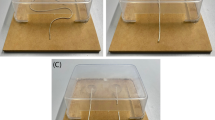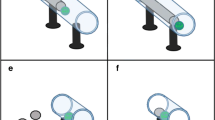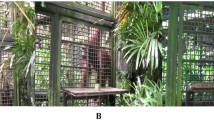Abstract
Most studies of animal tool use require subjects to use one object to gain access to a food reward. In many real world situations, however, animals perform more than one action in sequence to achieve their goals. Of theoretical interest is whether animals have the cognitive capacity to recognize the relationship between consecutive action sequences in which there may be one overall goal and several subgoals. Here we ask if cotton-top tamarins, a species that in captivity uses tools to solve means-end problems, can go one step further and use a sequence of tools (means) to obtain food (end). We first trained subjects to use a pulling tool to obtain a food reward. After this initial training, subjects were presented with problems in which one tool had to be used in combination with a second in order to obtain food. Subjects showed great difficulty when two tools were required to obtain the food reward. Although subjects attended to the connection between the tool and food reward, they ignored the physical connection between the two tools. After training on a two-tool problem, we presented subjects with a series of transfer tests to explore if they would generalize to new types of connections between the tools. Subjects readily transferred to new connections. Our results therefore provide the first evidence to date that tamarins can learn to solve problems involving two tools, but that they do so only with sufficient training.






Similar content being viewed by others
References
Anderson R, Henneman MC (1994) Solutions to a tool-use problem in a pair of Cebus apella. Mammalia 58:351–361
Boesch C, Boesch H (1990) Tool use and tool making in wild chimpanzees. Folia Primatol 54:86–99
Brewer SM, McGrew WC (1990) Chimpanzee use of a tool-set to get honey. Folia Primatol 54:100–104
Byrne RW (1999) Object manipulation and skill organization in the complex food preparation of mountain gorillas. In: Parker ST, Mitchell RW, Miles HL (eds) The mentalities of gorillas and orangutans: comparative perspectives. Cambridge University Press, Cambridge, pp 147–159
Byrne RW, Corp N, Byrne JME (2001) Estimating the complexity of animal behaviour: how mountain gorillas eat thistles. Behaviour 138:525–557
Corp N, Byrne RW (2002) Leaf processing by wild chimpanzees: physically defended leaves reveal complex manual skills. Ethology 108:673–696
Furlong EE, Bulloch MJ, Boose KJ, Boysen ST (2004) Raking it in: chimpanzees recognize the mechanical properties of tools. 11th Annual International Conference on Comparative Cognition, Melbourne, Fla, 25 March 2004
Hauser MD (1997) Artifactual kinds and functional design features: what a primate understands without language. Cognition 64:285–308
Hauser MD, Kralik J, Botto-Mahan C (1999) Problem solving and functional design features: experiments on cotton-top tamarins (Saguinus oedipus). Anim Behav 57:565–582
Hauser MD, Pearson HM, Seelig D (2002a) Ontogeny of tool-use in cotton-top tamarins (Saguinus oedipus): innate recognition of functionally relevant features. Anim Behav 64:299–311
Hauser MD, Santos LR (2005) The evolutionary ancestry of our knowledge of tools: from percepts to concepts. In: Margolis E, Laurence S (eds) Creations of the mind. Oxford University Press, Oxford (in press)
Hauser MD, Santos LR, Spaepen GM, Pearson HE (2002b) Problem solving, inhibition and domain-specific experience: experiments on cottontop tamarins, Saguinus oedipus. Anim Behav 64:387–396
Hihara S, Obayashi S, Tanaka M, Iriki A (2003) Rapid learning of sequential tool use by macaque monkeys. Physiol Behav 78:427–434
Köhler W (1925/1959) The mentality of apes. Vintage, New York
Matsuzawa T (1991) Nesting cups and metatools in chimpanzees. Behav Brain Sci 14:570–571
Matsuzawa T (1994) Field experiments on the stone tool by chimpanzees in the wild. In: Wrangham RW, McGrew WC, de Waal F, Heltne PG (eds) Chimpanzee cultures. Cambridge University Press, Cambridge, pp 196–209
Matsuzawa T (1996) Chimpanzee intelligence in nature and captivity: isomorphism of symbol-use and tool-use. In: McGrew WC, Marchant LF, Nishida T (eds) Great ape societies. Cambridge University Press, Cambridge, pp 196–212
Matsuzawa T (2001) Primate foundations of human intelligence: a view of tool use in non-human primates and fossil hominids. In: Matzusawa T (ed) Primate origins of human cognition and behavior. Springer, Tokyo Berlin Heidelberg, pp 3–25
Parker ST, Poti P (1990) The role of innate motor patterns in ontogenetic and experiential development of intelligent use of sticks in Cebus monkeys. In: Parker ST, Gibson KR (eds) “Language” and intelligence in monkeys and apes: comparative development perspectives. Cambridge University Press, New York, pp 219–243
Povinelli DJ (2000) Folk physics for apes: the chimpanzee’s theory of how the world works. Oxford University Press, Oxford
Santos LR (2004) Core knowledges: a dissociation between spatiotemporal knowledge and contact-mechanics in a non-human primate? Dev Sci 7:167–174
Santos LR, Hauser MD (2002) Dissociations between implicit knowledge and search behavior in cotton-top tamarins. Dev Sci 5:F1–F7
Santos LR, Miller CT, Hauser MD (2003) Representing tools: how two non-human primate species distinguish between the functionally relevant and irrelevant features of a tool. Anim Cogn 6:269–281
Stoinski TS, Beck BB (2001) Spontaneous tool use in captive, free-ranging golden lion tamarins (Leontopithecus rosalia rosalia). Primates 42:319–326
Tomasello M, Call J (1997) Primate cognition. Oxford University Press, New York
Visalberghi E, Trinca L (1989) Tool use in capuchin monkeys: distinguishing between performance and understanding. Primates 30:511–521
Whiten A, Goodall J, McGrew WC, Nishida T, Reynolds V, Sugiyama Y, Tutin CEG, Wrangham RW, Boesch C (1999) Cultures in chimpanzees. Nature 399:682–685
Yerkes R, Yerkes A (1929) The great apes. Yale University Press, New Haven, Conn.
Acknowledgements
The authors wish to thank Sebastien Fournier and Daniel Schaffer for their help running these studies. This research was approved by the Institutional Animal Care and Use Committee (USA) of Harvard University (Animal Research Protocol no. 92-16, approved 11/13/02). All of this research conforms to federal guidelines for use of animals in research. L.R.S. was supported by an NSF Predoctoral Fellowship and Yale University. M.D.H. was supported by the NSF (SBR-9357976), the NEPRC (PHS-P51RR00168-37) and Harvard University
Author information
Authors and Affiliations
Corresponding author
Rights and permissions
About this article
Cite this article
Santos, L.R., Rosati, A., Sproul, C. et al. Means-means-end tool choice in cotton-top tamarins (Saguinus oedipus): finding the limits on primates’ knowledge of tools. Anim Cogn 8, 236–246 (2005). https://doi.org/10.1007/s10071-004-0246-7
Received:
Revised:
Accepted:
Published:
Issue Date:
DOI: https://doi.org/10.1007/s10071-004-0246-7




